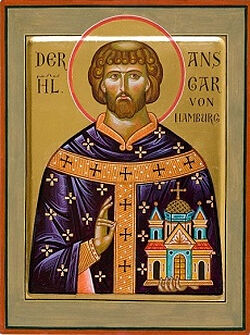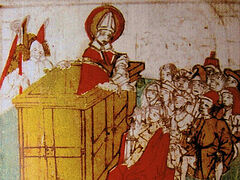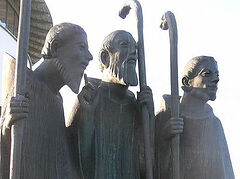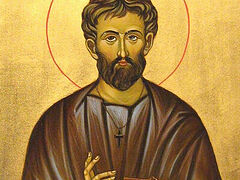 Traditional Scandinavian stave church: The Hopperstad Stave Church, Vestland, Norway, 11th cent.
Traditional Scandinavian stave church: The Hopperstad Stave Church, Vestland, Norway, 11th cent.
Introduction
The area collectively designated as Scandinavia consists of the present day countries of Denmark, Norway, and Sweden. The designation Scandinavia may come from the province of Scania in southern Sweden; at any rate, the term for the region is attested as early as Pliny’s Natural History. These lands are bound by deep and ancient ties of history, culture, and language.
For many centuries after the time of Christ and the establishment of His Church, and even after the Christianization of much of Western Europe, the Scandinavian lands remained inveterately pagan. The light of Christ was long in penetrating into these dark and distant northerly places. Norse mythology, with its violent and bloody pantheon and shamanistic ritual practices, held sway for many ages. With the initiation of the period of the great Viking raids beginning in the late 8th century, though, the ancient Scandinavian people began to make contact with Christian communities and cultures. Even if said contact occurred in the context of violent raids and often murderous plundering, nevertheless a seed of exposure at least was planted. But it would take the monumental labors of a pair of fearless missionaries to bring the light of the Orthodox Gospel of Christ to these lands. It is with them that the Christian story of Scandinavia properly begins.
1. Missionaries and Enlighteners:
St. Ansgar of Hamburg (†865)
St. Sigfrid of Växjö (†1050)
The evangelization of the Nordic lands, as we have said, was a comparatively late phenomenon compared to the rest of Western Europe. It was largely initiated by one man, who most certainly ranks among the great missionary saints in the history of the Church. This was St. Ansgar of Hamburg and Bremen, and our discussion of Orthodoxy in the Nordic lands begins, appropriately, with him.
 Icon of St. Ansgar of Hamburg St. Ansgar was born in Ameins in Gaul (present day France) in 801 into a family of the Frankish nobility. From a tender age—and all throughout his life—he was given to visions, which often guided and inspired him. Once, as a young boy, he beheld a vision of his recently deceased mother walking in a company with the Mother of God, which induced him to abandon childish frivolity and adhere to a serious and sober course of life.
Icon of St. Ansgar of Hamburg St. Ansgar was born in Ameins in Gaul (present day France) in 801 into a family of the Frankish nobility. From a tender age—and all throughout his life—he was given to visions, which often guided and inspired him. Once, as a young boy, he beheld a vision of his recently deceased mother walking in a company with the Mother of God, which induced him to abandon childish frivolity and adhere to a serious and sober course of life.
Raised in monasticism Corbey Abbey, he was later part of a small group sent to establish the monastery of New Corbey in Westphalia, northwestern Germany. There his principal duties consisted of teaching in the school and delivering homilies.
The work for which St. Ansgar is best remembered, and for which he bears the title “Apostle of the North,” is his pioneering missionary efforts in Denmark and Sweden. Venturing north first to Denmark, he established a school for boys. However, his first missionary effort in that land was to prove short-lived, and he was compelled to leave and return to Germany. Almost immediately afterwards he was invited to missionize Sweden, which commission he readily accepted. There he became the first person to ever preach the Gospel of Christ in that land. Gradually he began winning converts and establishing churches.
 St. Ansgar preaching the Gospel, with companion, the friar Witmar Appointed to the Archbishopric of Hamburg, from which post he could pursue his mission to the northern lands, St. Ansgar traveled to Rome where he was formally tasked by the pope with evangelizing the pagan nations of Denmark, Norway, and Sweden. He continued preaching and building churches and monasteries, facing grave dangers and frequent setbacks. An especially severe crisis occurred when pagan Danes sacked his see of Hamburg. His efforts were bolstered, however, when he was given the archbishopric of Bremen in addition to Hamburg after the see had become vacant, giving him a broader base for his missionary activities.
St. Ansgar preaching the Gospel, with companion, the friar Witmar Appointed to the Archbishopric of Hamburg, from which post he could pursue his mission to the northern lands, St. Ansgar traveled to Rome where he was formally tasked by the pope with evangelizing the pagan nations of Denmark, Norway, and Sweden. He continued preaching and building churches and monasteries, facing grave dangers and frequent setbacks. An especially severe crisis occurred when pagan Danes sacked his see of Hamburg. His efforts were bolstered, however, when he was given the archbishopric of Bremen in addition to Hamburg after the see had become vacant, giving him a broader base for his missionary activities.
St. Ansgar reposed peacefully of natural causes in 865, just one day after the Feast of the Meeting of the Lord. Ever since a visionary experience from his youth that had seemed to summon him to the path of martyrdom, he had yearned with all his soul for a martyr’s end. Though such a death was not granted him in the literal sense, his life of tireless labor, constant danger, sufferings, and reversals constituted a prolonged daily martyrdom. St. Ansgar gave all of himself to bring the light of Christ to distant peoples immured in pagan darkness. Despite his hardships and limited means, he was a generous almsgiver. He was also a severe ascetic who wore hairshirts and practiced a strict rule of discipline in all aspects of his daily life. Even during his lifetime he worked numerous miracles; when this was once remarked upon, the saint modestly insisted that he wished only that by a miracle he might himself become a good man.
A life of St. Ansgar, the Vita Ansgarii, was written by his disciple and successor to the Hamburg-Bremen Archbishopric, St. Rimbert (†888).
Despite the heroic nature of St. Ansgar’s labors, the pervasively entrenched paganism of the territories he evangelized meant that many of his gains were short lived. Before long, these newly enlightened areas relapsed to their former pagan darkness. But the seeds he planted would yet prove fruitful, and would come to greater fruition under another enlightener some years later: St. Sigfrid of Växjö.
 Icon of St. Sigfrid of Sweden St. Sigfrid is, after St. Ansgar, the second enlightener of the Nordic lands. In many ways his mission was a restoration and consolidation of St. Ansgar’s work, as many of the areas once converted by St. Ansgar had relapsed to paganism in the intervening two centuries. He thus built upon and rendered permanent the achievements of his great predecessor.
Icon of St. Sigfrid of Sweden St. Sigfrid is, after St. Ansgar, the second enlightener of the Nordic lands. In many ways his mission was a restoration and consolidation of St. Ansgar’s work, as many of the areas once converted by St. Ansgar had relapsed to paganism in the intervening two centuries. He thus built upon and rendered permanent the achievements of his great predecessor.
St. Sigfrid was born in Glastonbury, England’s Holy Land, sometime in the latter half of the 10th century. St. Alphege of Canterbury (†1012) is said to have converted him. Some sources on his life state that he became, at least briefly, Archbishop of York.
When the Norwegian king Olaf Tryggvason1, who had been brought to faith in Christ by the holy hermit St. Lide (comm. Aug. 8th) on the Scilly Isles off southern Britain, requested missionaries to return with him to Norway to re-evangelize his land, the English King Aethelred appointed Sigfrid to lead the mission. The holy man took up this summons with deep and laudable zeal.
The saint’s period of activity in Norway was eventful. He confronted a feared and powerful sorcerer, miraculously calming a storm which the latter had stirred up against him. He also discovered the incorrupt relics of St. Sunniva (see below) and established her veneration. Later he worked alongside Olaf Tryggvason’s successor, King St. Olaf (Haraldsson; see below) in the evangelization of Norway.
When Sweden’s king, also named Olaf, petitioned the English king for Christian missionaries to enlighten his land, St. Sigfrid took up the call. Here he would labor to the end of his life and accomplish his greatest work. In response to an angelic vision, he set up a cross and built a church in Växjö, which locale would thenceforth serve as the base of his activities.
Before long, his grace-filled preaching and miracles resulted in the conversion of twelve chiefs of the Goths, which resulted in a wave of conversions. Soon afterward, the king himself, along with his entire court and family, also received baptism. The king, Olaf the Swede, is now numbered among the saints, as is his daughter Ingegerd, better known as the holy princess St. Anna of Novgorod (see below in re: both Sts. Olaf and Anna).
St. Sigfrid was capably assisted in his missionary labors by his three nephews: The priest Unaman, the deacon Sunaman, and the sub-deacon Winaman. Leaving them behind in Växjö on one occasion while he traveled to preach in Denmark, he returned to find that a gang of pagans had brutally martyred them and ransacked the church. At his prayers the location of his nephews’ holy relics was miraculously disclosed to him. Recovering their severed heads from the bottom of the lake into which they had been cast, the heads were vouchsafed the power of speech and gave the names of their murderers. However, when the king proposed to execute the guilty, St. Sigfrid pleaded on their behalf, sparing their lives. The holy man also declined to accept the weregild, or blood money, that had been extracted from them—despite his impoverished situation.
St. Sigfrid continued his apostolic labors in Sweden into great old age and reposed in peace. His relics were placed in the church in Växjö, and were immediately glorified by miracles.
There are three disciples of St. Sigfrid worthy of mention here. These brave and dedicated men followed in his footsteps and continued his apostolic labors, spreading the Gospel to previously unenlightened areas of Sweden. While they each reposed sometime after the Schism of the West from the Orthodox Church, they were close disciples of a saint and there seems to be some basis for veneration of them since, due to its remoteness, the effects of the Schism likely did not penetrate into Sweden or the Nordic lands generally for some time afterwards.
David of Munktorp (†1082) was an English-born Cluniac monk personally called by St. Sigfrid to assist in the evangelization of Sweden. With Eskil (†c.1080) and Botvid (†1120), he labored chiefly in the landskaps, or provinces, of Södermanland in the southeast and Västmanland in central Sweden. He is considered the apostle to Västmanland. Eskil, also of English birth, is considered the patron of Södermanland. He may have been a relative of St. Sigfrid. He was violently slain after breaking up a Norse pagan ritual; a holy spring gushed forth from a place by a mountain where his body was laid. Botvid, the last of this trio, was, unlike the others, actually of Swedish birth. But he travelled to England and was there converted to Christ, whereupon St. Sigfrid summoned him back to his native land as a missionary. Botvid accompanied David and Eskil in their itinerant preaching and suffered a violent death in the year 1120.
This concludes our look at the lives and labors of the enlighteners of the Nordic lands. Though these areas received the Gospel at a late date, and remained mired in paganism in many parts for a long time thereafter, the holy deeds and wondrous accomplishments of these great missionaries remains undimmed, summoning all of us to persist in pursuing God’s will for our lives even in the face of challenges, setbacks, and even dangers. May we have their prayers!
To be continued…




